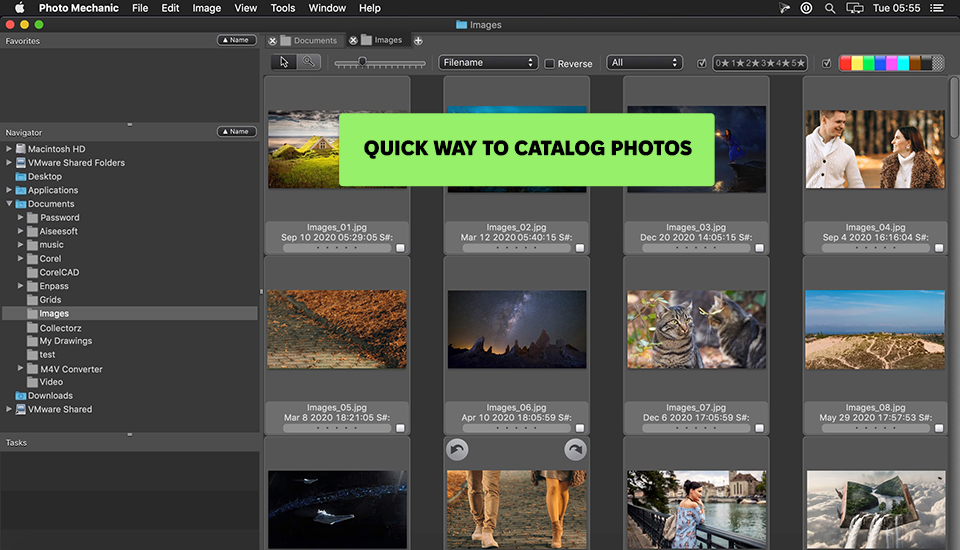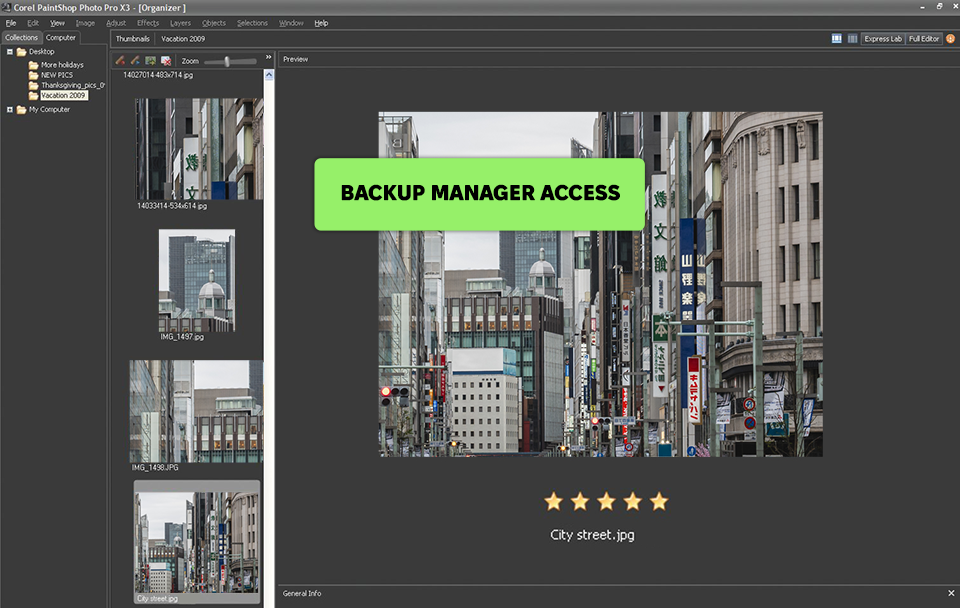When I felt the urge to have a database that stores a record for each of my images, I began to test different photo catalog software.
They keep the most essential info about each of my images: a reference to where the photo is on my system, a detailed description of how I want to process the photo, and metadata, such as ratings and keywords that I apply to pics for their quick search and organization.
The operating system of your PC can have handy tools for creating catalogs like MacOS Photos. However, such standard programs usually fail to handle a constantly growing number of pics, especially if they are in RAW format. Therefore I recommend trying out the following image cataloging software and paying attention to the following functions.
Tagging. By adding tags to images, you can search and filter them with ease. The best photo catalog app allows creating a hierarchy of tags, narrowing down your search. Batch tagging, which is designed for selecting a group of pics and tagging them all at once, accelerates the categorization process.
Ratings. The ability to rate your images and filter them by rating is essential.
Color Tagging. This can provide you with a quick visual idea of the category of a pic.
Date. The chosen program should filter the assets by a date or date range.
Location. If you shoot with a device with a GPS feature like a smartphone, your images will contain geolocation. A highly functional software will let you tag, sort, and filter photos by location.
Metadata. Images shot with cameras contain metadata like the date, the type of camera, and possibly the camera settings. With reliable image categorization software, you can edit and add to the metadata, as well as use the info in searches and filters.
Facial Recognition. The majority of apps leverage face recognition technology for tagging be person in a flash.
Automatic Content Tagging. More advanced tools leverage AI technology to define and tag the content of images.
Support for a wide range of formats. Large organizations getting pics from multiple resources will need software that supports many different picture and metadata formats.

Verdict: Adobe Lightroom is my favorite image catalogue tool because of several reasons like the ability to store pics anywhere and edit photos non-destructively. The catalog keeps a preview of each photo, so I can process pics in Lightroom Classic and evaluate the editing changes in an instant.
Having a cloud-based nature, the program seamlessly integrates with the Adobe ecosystem, including a free version of Adobe Bridge, which is a central management solution for individual creative assets. This means that you won’t have trouble handling even large photo collections. It also has a rich selection of cataloging tools, making it an ideal solution for individual graphic designers and photographers.
Adobe Lightroom has a free trial, whereas the cost of a subscription starts at $19.99/mo. It is great that the developers often offer Adobe discounts on the official website.

Verdict: I like that once uploaded to Google Photos, the images and videos are added to the cloud storage and organized automatically. Besides, the assets are available for search at once.
It is also possible to share them with anyone without worrying about available storage space. I can set up backup and sync to view certain folders automatically and upload them to my Google Photos account. They will be displayed on the timeline, using the AI-Assistant function for organizing albums and recommending photos for archiving. It's a little more complicated, but you will get used to it.
This photo organizing software is free, but if you need more storage, get ready to spend some money. 100GB of storage cost $2/month, 200GB - $3/month, and 2TB - $10/month. Those, who want to get 30TB of storage have to shell out $150 every month.

Verdict: Photo Mechanic is an excellent photo cataloging solution, which allows importing and cataloging multiple photos at once quickly and easily. But before uploading them, I configured tagging options for the entire batch to be able to categorize the pics by the location, the event, copyright information, and more.
While importing the images, I could add ratings, labels, and keywords to each specific image. For a photographer like me who always needs to meet strict deadlines, this photo culling software is a real find. Although it does not have facial recognition, auto-tagging, advanced photo editing, or other handy features, it seamlessly integrates with Lightroom and other programs.
You can also test the program for free for 2 weeks. The price of a monthly subscription starts from $17.

Verdict: Canto DAM appealed to me with advanced business features. This DAM software for photographers offers revolutionary security, ensuring that sensitive image files are protected from unauthorized use. Canto automatically applies all the needed security measures to saved and loaded images. The main reason why it is so useful for companies is metadata management tools that allow users to find saved images based on keywords.
For example, if you have thousands of images of the Atlantic Ocean in your database, you can search for the “ocean” to find them. Metadata searches can be broad or specific, depending on the peculiarities of your project.
There are 2 pricing plans to choose from. The first is actually a free trial, which means you have to tolerate restrictions. Another option is a full-featured program and you need to contact the company’s representatives to buy it. Keep in mind that the price depends on your needs and business type.

Verdict: PaintShop Pro groups photos by keywords, calendar dates, and categories to rate photos and search for them more efficiently. It is also possible to access the backup manager and view the EXIF and IPTC metadata of my photos to check the settings of my camera when I took the picture. However, the software cannot search and delete duplicate images, so you have to do it manually.
This software also removes unwanted objects from my images and fills the space realistically. I was impressed when I tested this feature. Sometimes I had to make several attempts to get the desired output. However, in the result, one cannot even think that the deleted item was present in the original photo. There are paintbrushes and pencils, as well as a tool for removing stains and healing.
Many experienced photographers even compare PaintShop Pro vs Photoshop when it comes to managing images. The program offers a full 30-day free trial. When the period expires and you want to continue using this photo catalogue software, get ready to pay $79.99 for the license.

Verdict: I like this program because it can easily cope with any size collection without the loss of performance. Other notable features of Daminion are its support for multiple users, strict access, and version control. Unlike other photo editing software for PC, it does not have editing functionality. Besides, it integrates easily with Lightroom via a plug-in.
Daminion has fantastic tagging features like custom tags, hierarchical tags, and batch tagging. Its support of virtually any metadata format is another bonus. The ability to add custom metadata like copyright info is also great. When uploading my photos, Daminion leverages AI algorithms for content analysis and tagging pics accordingly. This accelerates my workflow considerably when I import massive collections.
Daminion DAM pricing is only revealed upon request.

Verdict: Eagle is the most approachable digital assets management for small companies and creative experts. Eagle App offers top customer service and agile management of your brand and design content, preview of more than 90+ formats, grouped by colors, shapes and even more.
You are also able to protect your private assets with a password. Another advantage is that it perfectly functions while completing multiple tasks such as multi-selected, classify or add-tag ones simultaneously. With the program you can automatically control file duplication while collecting pictures. Moreover, it enables you to set default folder tag and refer to any of the resources included in the folder.
As for me, Lightroom provides the easiest and the most reliable way to catalog photos. Users with any level of experience will benefit from Lightroom’s varied cataloging features, ability to edit photos, and integration with other Adobe tools and Adobe Stock to process large collections almost effortlessly.